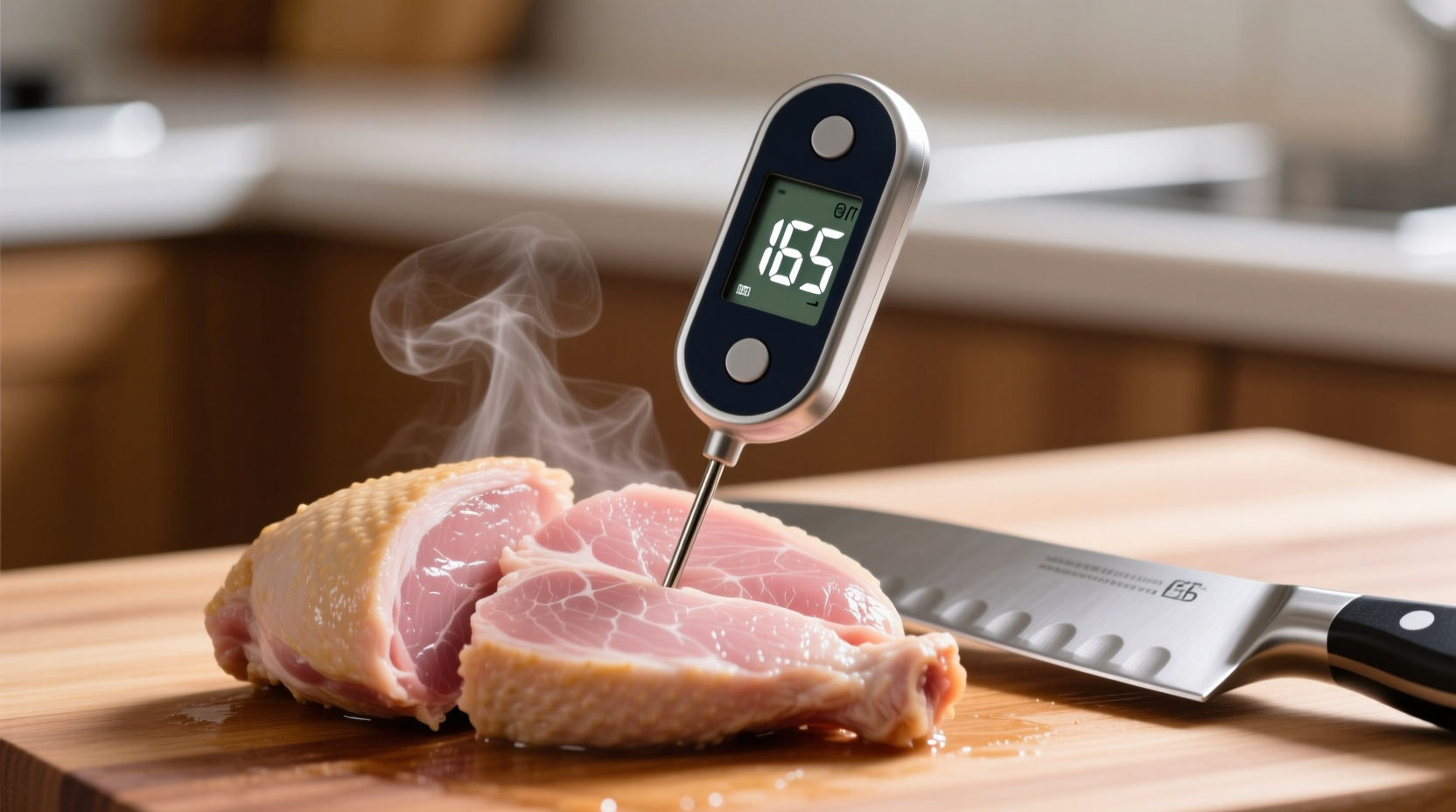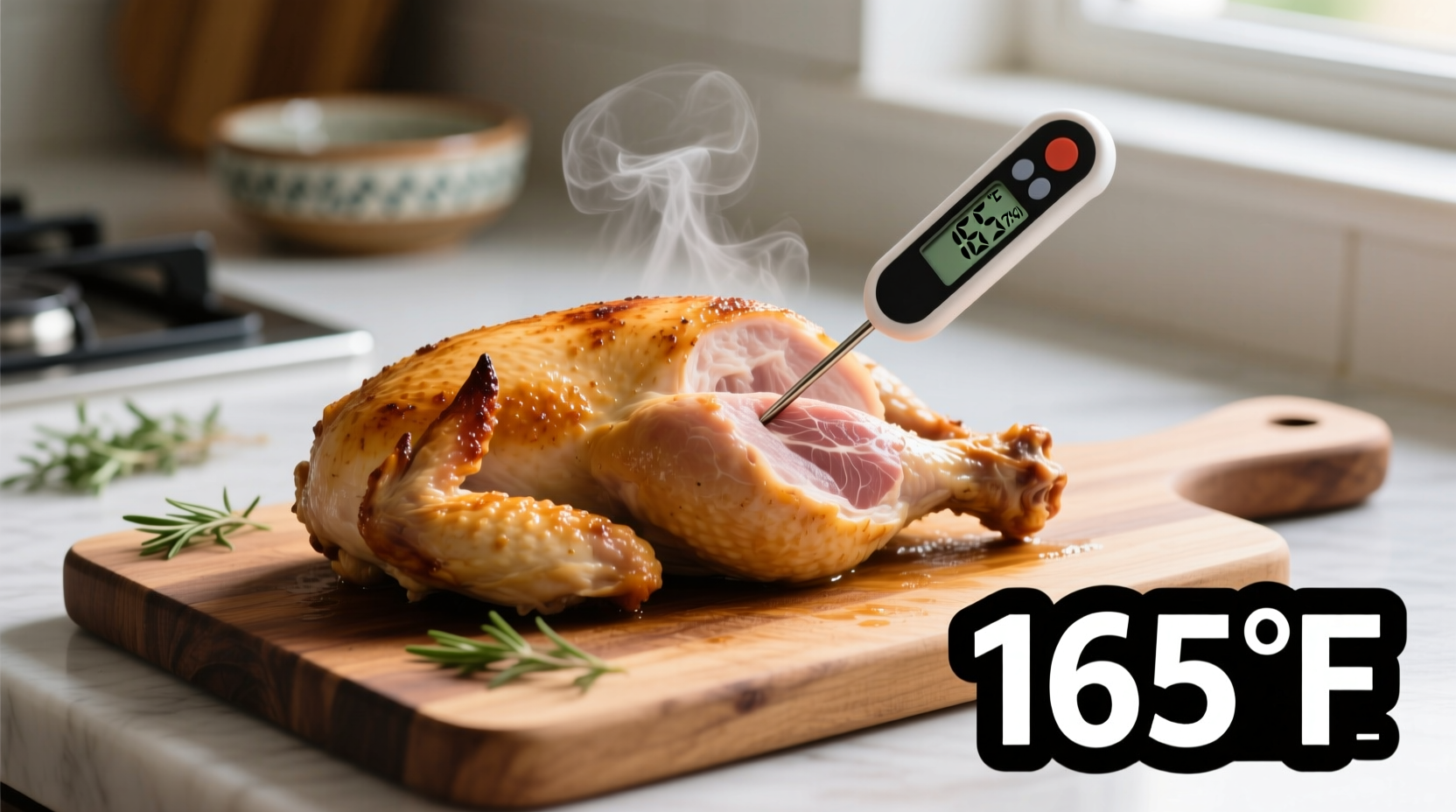The safe minimum internal temperature for all poultry, including chicken breasts, thighs, wings, and ground chicken, is 165°F (74°C) as measured with a food thermometer. This temperature destroys harmful bacteria like Salmonella and Campylobacter that can cause foodborne illness.
Why 165°F Is Non-Negotiable for Chicken Safety
When you're preparing chicken, getting the temperature right isn't just about perfect texture—it's a critical food safety requirement. According to the USDA Food Safety and Inspection Service, chicken must reach 165°F (74°C) to eliminate dangerous pathogens. Unlike beef or pork, poultry requires this higher temperature because bacteria like Salmonella can penetrate deep into the muscle tissue, not just reside on the surface.

Your Step-by-Step Guide to Perfectly Cooked Chicken
1. Selecting and Using the Right Thermometer
Not all thermometers deliver accurate readings. For best results:
- Use an instant-read digital thermometer (tested accuracy within ±0.5°F)
- Insert the probe into the thickest part of the meat, avoiding bones
- Wait 10-15 seconds for the reading to stabilize
- Sanitize between measurements when checking multiple pieces
2. Understanding Temperature Zones in Chicken
Chicken isn't uniform in thickness, creating different temperature zones:
| Chicken Cut | Thickest Area | Recommended Check Points |
|---|---|---|
| Breast (boneless) | Center, away from fat pockets | Multiple points across the thickest section |
| Thigh (bone-in) | Meat closest to bone | Between bone and outer skin |
| Whole chicken | Inner thigh and breast | Both areas must reach 165°F |
| Ground chicken | Center of patty | Multiple patties in batch |
3. The Science Behind the 165°F Standard
Food safety researchers determined 165°F as the minimum safe temperature through extensive testing. At this temperature:
- Salmonella is destroyed in less than 1 second
- Pathogenic E. coli bacteria cannot survive
- Campylobacter, a common poultry contaminant, is eliminated
While some chefs claim lower temperatures (150-160°F) are safe with proper resting time, the USDA maintains 165°F as the only reliably safe temperature for home cooks without professional equipment.
Common Misconceptions About Chicken Temperature
"The juices run clear" Myth
Many home cooks rely on visual cues like clear juices or firm texture, but these indicators are unreliable. According to research published by the Centers for Disease Control and Prevention, chicken can appear fully cooked (white throughout, clear juices) while still harboring dangerous bacteria at temperatures below 165°F.
Temperature Variations by Cooking Method
Regardless of cooking method—grilling, baking, pan-searing, or sous vide—the final internal temperature must reach 165°F. The USDA confirms this standard applies universally across all cooking techniques. When using sous vide, while you can cook chicken at lower temperatures for extended periods, the final sear must still bring the surface to 165°F to eliminate surface bacteria.
Avoiding Overcooked Chicken While Ensuring Safety
Many home cooks struggle with dry, overcooked chicken even when following temperature guidelines. Here's how to achieve juicy results while maintaining safety:
- Pull chicken at 160°F: Remove from heat when thermometer reads 160°F—the residual heat will carry it to 165°F during resting
- Rest properly: Tent with foil and rest for 5-10 minutes (breasts) or 10-15 minutes (thighs/whole chicken)
- Brine before cooking: A 30-minute brine in 1/4 cup salt dissolved in 4 cups water improves moisture retention
- Use carryover cooking: Understand that temperature will rise 3-5°F during resting
Special Considerations for Different Chicken Cuts
While the 165°F rule applies universally, different cuts require different approaches:
- Breasts: Most prone to drying out—pull at 160°F and rest 5-7 minutes
- Thighs and drumsticks: More forgiving due to higher fat content—can be cooked to 170-175°F for more tender results
- Ground chicken: Must reach 165°F throughout due to increased surface area where bacteria can thrive
- Stuffed chicken: Both the chicken and stuffing must reach 165°F
What Happens If You Don't Reach 165°F?
Consuming undercooked chicken poses serious health risks. According to the FDA Food Code, chicken between 40°F and 140°F enters the "danger zone" where bacteria multiply rapidly. At 160°F, it takes 14 seconds to destroy Salmonella, but at 150°F, it requires 3 minutes. Home cooks lack the precision to maintain these lower temperatures safely, making 165°F the only recommended standard.
Essential Tools for Perfect Chicken Every Time
Invest in these tools to ensure accurate temperature measurement:
- Digital instant-read thermometer (Thermoworks Thermapen recommended)
- Leave-in probe thermometer for roasting
- Calibration ice bath (to verify thermometer accuracy monthly)
- Temperature reference chart taped near your cooking area
When in Doubt, Throw It Out
If you're uncertain whether your chicken reached 165°F, the safest practice is to discard it. Food poisoning from undercooked poultry can cause severe symptoms including diarrhea, fever, and abdominal cramps that may last 4-7 days. The CDC estimates Salmonella causes over 1.35 million illnesses annually in the United States alone.











 浙公网安备
33010002000092号
浙公网安备
33010002000092号 浙B2-20120091-4
浙B2-20120091-4